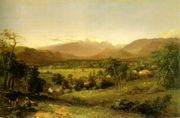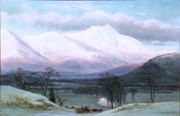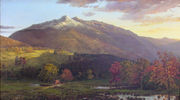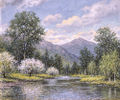White Mountain art
2007 Schools Wikipedia Selection. Related subjects: Musical genres, styles, eras and events
In the early part of the 19th century, artists ventured to the White Mountains of New Hampshire to sketch and paint. Many of the first artists were attracted to the region because of the 1826 tragedy of the Willey family, in which nine people lost their lives in an avalanche. These early works portrayed a dramatic and untamed mountain wilderness. The images stirred the imagination of affluent Americans, primarily from the large cites of the northeast, who traveled to the White Mountains to view the scenes for themselves. Others soon followed: inn keepers, writers, scientists, and, of course, more artists. The White Mountains thus began to assume their place as a major attraction for people from the New England states and beyond. The beauty of the region was soon to be shared by others who, because of lack of means, distance, or other circumstance, could not visit but were able to purchase paintings or prints depicting the area. Thus, during the ensuing years of the 19th century, art, tourism, and the economy of the region became inextricable linked.
Transportation improved to the region; inns and later Grand Hotels, complete with their "artists in residence," were built. Benjamin Champney (1817-1907], one of the early artists, popularized the Conway Valley. Other artists preferred the Franconia area, and yet still others ventured to Gorham, Shelburne and the communities of the north. Although these artists all painted the same picturesque views of the White Mountains, each had a unique style of his own. These landscape paintings in the Hudson River tradition, however, eventually fell out of favour with the public, and, by the turn of the century, it was the end of an era of White Mountain art.
The Willey tragedy
On 28 August 1826, torrential rains in the White Mountains caused a mudslide on Mount Willey. The Willey couple, with their five children, lived in a small house in the notch between Mounts Willey and Webster. They evacuated their home with the help of two hired men to escape the landslide, but all seven Willeys and the two hired men died in the avalanche. They were all buried in a mass of earth, stones, and trees while their home miraculously survived. Rescuers later found an open Bible on a table in the Willey home, indicating that the family retreated in haste.
The news of the Willey tragedy quickly spread across the nation. During the ensuing years, it would become the subject for literature, drawings, local histories, scientific journals, and paintings. The disaster started a new awareness of the American landscape and the raw wilderness of the White Mountains. This allure — tragedy and untamed nature — was a powerful draw for the early artists who painted in the White Mountains of New Hampshire (Purchase 1999).
The first artists
One of the first artists to work in the White Mountains was Thomas Cole (1801-1848), founder of the style of painting that would later be called the Hudson River School. Cole’s 1839 work, A View of the Pass Called the Notch of the White Mountains, is perhaps the best known and finest example of early 19th-century White Mountain art. Two other early White Mountain painters were Massachusetts artists Alvan Fisher (1792-1863) and Thomas Doughty (1793-1856). The works of all of these artists, depicting dramatic landscapes and man’s insignificance to nature, helped popularize the region.
Beginning in the 1830s, the landscape painters of the Hudson River School "sought to define America and what it was to be an American. Artists of that time saw themselves as scientists making documents that expressed Christian truths and democratic ideals" (Keyes 1996:91).
In 1851, John Frederick Kensett (1816-1872) produced a monumental canvas of Mount Washington that has become an icon of White Mountain art. Mount Washington from the Valley of Conway], purchased by the American Art Union, was made into a print by the engraver James Smillie (1833-1909) and distributed to 13,000 Art Union subscribers throughout the country. Many artists painted copies of this same scene from the print, and Currier and Ives published a similar print in about 1860. Kensett’s painting is another example of a work of art that helped to popularize the region.
Travel to the region
Early coach travel to the White Mountains was long, dusty, and uncomfortable. Before the advent of rail travel, a stagecoach ride from Portland, Maine to Conway, New Hampshire, a mere fifty miles, took a day. When the Atlantic and St. Lawrence Railroad completed its route from Portland to Gorham in 1852, tourists and artists could travel in comfort to the White Mountains, and were a mere eight miles from Mount Washington.
Although rail lines to North Conway were not complete until the early 1870s, an innkeeper in the area, Samuel Thompson, established coach service from Conway to North Conway and, subsequently, to Pinkham Notch. Thompson is also credited with enticing artists to North Conway in order to promote the region. In the early 1850s, Thompson convinced a young artist, Benjamin Champney (1817-1907), to visit North Conway. This artist would change the course of landscape painting throughout the region by becoming the father of the "White Mountain School."
Benjamin Champney and the allure of North Conway
Benjamin Champney, a New Hampshire native, made his first trip to the White Mountains in 1838 on a summer excursion. As an emerging artist in the second half of the 19th century, Champney’s style was influenced by the Hudson River School, yet he developed a unique style of his own.
In 1853, Champney bought a home in North Conway and spent the rest of his life painting in the greater Conway area. He attracted other artists to the region and opened his studio to them as well as tourists.
- "My studio has been the resort of many highly cultivated people from all parts of our country and even from foreign lands, and I have enjoyed much and learned much from the interchange of ideas with refined and intelligent minds. But I can relate a little incident of quite another kind. A party had been bustling around the studio making loud remarks about the paintings. At last they caught sight of me in my adjoining workroom and cried out: 'Now let's go and see him perform!' This I thought a good joke and allowed them to come in" (Champney 1900:159).
In 1858, Champney painted a view of Mount Washington from Sunset Hill that looks down on his house and backyard, and out across North Conway’s Intervale. The house still stands; the yard where Champney painted the scene is now the location of the Red Jacket Inn. Looking out across the Intervale, it is easy to imagine why the artists found this view so picturesque.
Largely because of Champney’s promotion of the area, many artists flocked to North Conway in the summer to paint. The area was filled with artists painting "en plein air." In 1855, North Conway had become " … the pet valley of our landscape painters. There are always a dozen or more here during the sketching season, and you can hardly glance over the meadows, in any direction, without seeing one of their white umbrellas shining in the sun" (The Crayon, 1855:217). By the mid 1850s, North Conway had arguably become the first "artist colony" in the United States. Winslow Homer (1836-1910) depicted these artists in his 1868 painting titled Artists Sketching in the White Mountains.
Later artists
In all, over four hundred artists are known to have painted White Mountain views during the 19th century (Campbell 1985). They came from the Boston area, Maine, Pennsylvania, and New York. Most of the Hudson River School painters worked in the White Mountains while maintaining studios in New York City, including such well-known artists as Sanford Robinson Gifford (1823-1880) and Jasper Francis Cropsey (1823-1900). A complete list of these artists, many with biographies, can be found at White Mountain Art & Artists.
Most artists came to the White Mountains in the summer, but returned to their urban studios, or sometimes to warmer climates like Florida, in the winter. Therefore, paintings of winter scenes are not common. A few artists, like Champney and Edward Hill, had homes in New Hampshire and would sometimes paint winter scenes. Frank Henry Shapleigh had a home in Jackson, and was a prolific painter of New Hampshire scenes, both in summer and winter.
By mid-century, painters would change their style from idealized views to depict more literal views of the mountains. As an example of how literal these depictions were, see the composite image where a painting by George Albert Frost of Franconia Notch is compared to a photograph of the scene today.
The Grand Resort Hotels
It was during the 1860s that many of the region's resort hotels were built and became popular as major summer destinations for affluent city dwellers from Boston and New York. During the latter half of the 19th century, many of the artists took up residence at one of these grand hotels and became known as "artists-in-residence." This arrangement had advantages for both the artist and the hotel. Once established, the artists would invite guests to their studios to view their works. The guests would purchase original works to bring home as a remembrance of the White Mountains. The hotel benefited by having another "attraction" to lure guests for an extended stay.
Two well known artists-in-residence were Edward Hill (1843-1923) and Frank Henry Shapleigh (1842-1906). Hill worked at the Profile House in Franconia Notch for fifteen years, from 1877 to 1892, and spent shorter stays at the Waumbek Hotel and the Glen House. Frank Shapleigh was the artist-in-residence at the Crawford House in Crawford Notch for sixteen years, from 1877 to 1893.
Working in North Conway, Franconia, and points north
A favorite spot for viewing and painting Mount Washington was Sunset Hill in North Conway. Other frequently painted views in the Conway area included Moat Mountain, Mount Kearsarge, Mount Chocorua, Pinkham Notch, and Crawford Notch.
Many artists also traveled to the Franconia Notch region of the White Mountains to paint. A rivalry developed between the Franconia artists and the North Conway artists. Each faction believed that their location had the most beautiful view of the mountains. Further, those who preferred Franconia felt that North Conway, as early as 1857, had been despoiled by tourists! In a letter to The Crayon in 1852, the author compares the cider in West Campton to that of North Conway.
- "In the evenings, which are now growing cool, we assemble in gay gossip about the hearth of our bar-room – by name only – since it is really a very quite household apartment, the ‘Stag and Hounds,’ etc., being a temperance establishment, prohibitory of all fluids, excepting only ‘hard cider,’ of which our host supplies an aqueduct at dinner time. I am very sure they have no such cider at Conway!" (The Crayon, 1856:317-318).
In the Franconia region, artists painted Mount Lafayette, Franconia Notch, Eagle Cliff, and New Hampshire's favorite icon, the Old Man of the Mountain.
Fewer artists worked in the area north of the Presidential Range. Those who did painted less well-known, but equally beautiful, scenes from Shelburne, Gorham, and Jefferson. These locations were strategically located along train or coach routes from Gorham and Franconia.
Characteristics of the artists
Each White Mountain artist had certain characteristics that would distinguish his work from that of other artists. These characteristics are often more suggestive of an artist than even his signature, since signatures are sometimes forged.
Benjamin Champney was a master at painting water and is known for warm autumn colors. William F. Paskell, in his later style, used broad brushstrokes and bright colors to create an impressionistic feeling. George McConnell was known for the velvety pastel look of his paintings. Edward Hill often created a canopy-like depiction of trees to frame and accentuate the focus of a painting, a technique that gave many of his works a feeling of intimacy and solitude. Many of the works of Samuel Lancaster Gerry included dogs, people on horseback, and women and men in red clothing, although he is well known for his paintings of The Old Man of the Mountain. Francis Seth Frost was known to use small figures, wispy clouds, and an oval format. Alfred Thompson Bricher was known for his quiet, calm water. Sylvester Phelps Hodgdon painted at the extremes of the day – sunrise and sunset scenes – and often in Franconia Notch. John White Allen Scott frequently painted passing storm clouds in his skies. Frank Henry Shapleigh had his own slightly primitive style and used the same "props" over and over again in his paintings. He is known for painting landscapes as seen from the inside of a house or barn looking out through an open door or window. Inside the room would be such props as a ladder back chair, a cat, a basket, a straw hat, a broom, and/or a tall clock.
The end of an era
The scenes these artists painted became American icons, or at least icons to the people of New England. As tourists took these White Mountain paintings home, they were widely dispensed throughout the country. Today, these paintings are often discovered as far away as California.
By the latter part of the 19th century, landscape images, such as Mount Washington, had lost their appeal with the public. Newer images, such as those of the Rocky Mountains, were outweighing interest in the White Mountains. Also, landscapes in the Hudson River style were "usurped both by new artistic ideas and by the social and technological changes that were rapidly occurring in the region and throughout the country" (Keyes 1996:99). By the end of the 19th century, these factors, and the advent of photography, led to the gradual decline of White Mountain landscape painting. Many of these paintings, however, are preserved in both private collections and public institutions. Some fine examples of these paintings can be seen at the New Hampshire Historical Society in Concord, NH, the Currier Museum of Art in Manchester, NH, and at the Hood Museum of Art in Hanover, NH.















